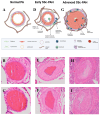Systemic Sclerosis-Associated Pulmonary Arterial Hypertension: From Bedside to Bench and Back Again
- PMID: 38731946
- PMCID: PMC11084945
- DOI: 10.3390/ijms25094728
Systemic Sclerosis-Associated Pulmonary Arterial Hypertension: From Bedside to Bench and Back Again
Abstract
Systemic sclerosis (SSc) is a heterogeneous disease characterized by autoimmunity, vasculopathy, and fibrosis which affects the skin and internal organs. One key aspect of SSc vasculopathy is pulmonary arterial hypertension (SSc-PAH) which represents a leading cause of morbidity and mortality in patients with SSc. The pathogenesis of pulmonary hypertension is complex, with multiple vascular cell types, inflammation, and intracellular signaling pathways contributing to vascular pathology and remodeling. In this review, we focus on shared molecular features of pulmonary hypertension and those which make SSc-PAH a unique entity. We highlight advances in the understanding of the clinical and translational science pertinent to this disease. We first review clinical presentations and phenotypes, pathology, and novel biomarkers, and then highlight relevant animal models, key cellular and molecular pathways in pathogenesis, and explore emerging treatment strategies in SSc-PAH.
Keywords: biomarkers; molecular pathogenesis; pulmonary arterial hypertension; pulmonary hypertension; scleroderma; systemic sclerosis; therapeutics.
Conflict of interest statement
The authors declare no conflicts of interest.
Figures


Similar articles
-
Impaired bone morphogenetic protein receptor II signaling in a transforming growth factor-β-dependent mouse model of pulmonary hypertension and in systemic sclerosis.Am J Respir Crit Care Med. 2015 Mar 15;191(6):665-77. doi: 10.1164/rccm.201408-1464OC. Am J Respir Crit Care Med. 2015. PMID: 25606692
-
Utility of factor D and other alternative complement factors as biomarkers in systemic sclerosis-associated pulmonary arterial hypertension (SSc-PAH).Semin Arthritis Rheum. 2024 Dec;69:152554. doi: 10.1016/j.semarthrit.2024.152554. Epub 2024 Sep 13. Semin Arthritis Rheum. 2024. PMID: 39298973
-
Systemic sclerosis-associated pulmonary arterial hypertension is characterized by a distinct peripheral T helper cell profile.Rheumatology (Oxford). 2024 Sep 1;63(9):2525-2534. doi: 10.1093/rheumatology/keae190. Rheumatology (Oxford). 2024. PMID: 38552313 Free PMC article.
-
Endothelial to mesenchymal transition (EndoMT) in the pathogenesis of Systemic Sclerosis-associated pulmonary fibrosis and pulmonary arterial hypertension. Myth or reality?Matrix Biol. 2016 Apr;51:26-36. doi: 10.1016/j.matbio.2016.01.012. Epub 2016 Jan 22. Matrix Biol. 2016. PMID: 26807760 Free PMC article. Review.
-
Vascular endothelial injury assessed with functional techniques in systemic sclerosis patients with pulmonary arterial hypertension versus systemic sclerosis patients without pulmonary arterial hypertension: a systematic review and meta-analysis.Rheumatol Int. 2021 Jun;41(6):1045-1053. doi: 10.1007/s00296-021-04850-2. Epub 2021 Apr 8. Rheumatol Int. 2021. PMID: 33830321
Cited by
-
An international perspective on the future of systemic sclerosis research.Nat Rev Rheumatol. 2025 Mar;21(3):174-187. doi: 10.1038/s41584-024-01217-2. Epub 2025 Feb 14. Nat Rev Rheumatol. 2025. PMID: 39953141 Review.
-
Exploring the Genetic Association Between Connective Tissue Diseases and the Risk of Pulmonary Arterial Hypertension: A Mendelian Randomization Analysis.Pulm Circ. 2024 Dec 24;14(4):e70033. doi: 10.1002/pul2.70033. eCollection 2024 Oct. Pulm Circ. 2024. PMID: 39720342 Free PMC article.
-
Juvenile Systemic Sclerosis Presenting With Severe Pulmonary Vascular Disease: ECMO Stabilization During Aggressive Therapy Resulting in a Favorable Outcome.Pulm Circ. 2025 Jun 3;15(2):e70106. doi: 10.1002/pul2.70106. eCollection 2025 Apr. Pulm Circ. 2025. PMID: 40463491 Free PMC article.
References
-
- Avouac J., Airo P., Meune C., Beretta L., Dieude P., Caramaschi P., Tiev K., Cappelli S., Diot E., Vacca A., et al. Prevalence of pulmonary hypertension in systemic sclerosis in European Caucasians and metaanalysis of 5 studies. J. Rheumatol. 2010;37:2290–2298. doi: 10.3899/jrheum.100245. - DOI - PubMed
Publication types
MeSH terms
Substances
LinkOut - more resources
Full Text Sources
Medical

